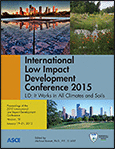Optimizing Green Roof Design for Evapotranspiration
Publication: International Low Impact Development Conference 2015: LID: It Works in All Climates and Soils
Abstract
Green roofs are an effective, yet costly stormwater control measure that reduces runoff volume through ET and can provide other services, such as improved building insulation and reduced urban heat island effect. For green roof systems to be competitive as a low-impact development strategy, they must be designed to maximize ET. Understanding each component's process in a green roof design is the key to designing a green roof to perform optimally. Evapotranspiration (ET) is a primary mechanism for removal of water in a green roof. When adequate water is available, the ET rate is limited by the energy available. However, when the system is water limited then less ET will occur than is climatologically possible, thus causing the green roof to perform suboptimally. One way to retain more water within the green roof is to minimize drainage (outflow) by altering or restricting the drainage layer within a green roof. In the present work, a green roof with a drainage layer is compared with a lysimeter without a drainage layer to determine if hydrologic performance is enhanced or compromised in either system. Preliminary results from the Villanova University green roof systems show that the underdrained system has approximately 65% of rainfall go to ET, while the undrained system showed 77% ET from April through November 2013. However, the system without drainage has seen as high as 88% annually go to ET in drought years. Additionally, the plants appeared healthier during the drought in the undrained system than in the drained system. Delving deeper into quantifying ET and optimizing green roof design, the elements that are related to ET must be better understood. A small-scale study was constructed to isolate the role of solar radiation in observed ET rates for a green roof mesocosm. Preliminary results indicate that, as expected, plants provide shading and decrease temperature fluctuations throughout the day; the next phase will be to understand the impact on ET rates. Overall, this research is part of a longer-term goal to quantitatively understand and properly estimate and accredit ET for widespread green roof implementation as an LID strategy.
Get full access to this article
View all available purchase options and get full access to this chapter.
Information & Authors
Information
Published In
Copyright
© 2015 American Society of Civil Engineers.
History
Published online: Jan 15, 2015
Authors
Metrics & Citations
Metrics
Citations
Download citation
If you have the appropriate software installed, you can download article citation data to the citation manager of your choice. Simply select your manager software from the list below and click Download.
